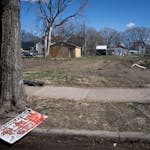U.S. Bank Stadium and three downtown Minneapolis high-rise office buildings account for a high proportion of bird fatalities among 21 downtown buildings surveyed.
The stadium and the three unidentified buildings were involved in 74% of bird collisions and 68% of bird fatalities among the buildings studied in a groundbreaking report on bird mortality released Wednesday.
The $300,000 study, published in the scientific journal PLOS One, was paid for by the Vikings and the Minnesota Sports Facilities Authority (MSFA) and prompted by conservationist concerns about birds following the Mississippi River corridor only to collide with the stadium's high glass walls.
Using data collected during two migratory seasons, it found that an estimated 111 bird fatalities occurred annually at the stadium. By way of comparison, annual fatality estimates at all four buildings ranged from 79 to 216.
Three problems elevating bird mortality were outlined: lighting in and around buildings at night; expanses of reflective glass; and vegetation near glass that causes birds to see trees reflected and believe they're flying into habitat.
The Vikings and MSFA issued a joint statement saying they're "committed to further evaluating" recommendations to mitigate bird deaths. They stopped short of committing to film or etchings on the glass that would deter birds, though they pledged to consider use of the National Audubon Society's "lights out" guidelines, especially during migratory seasons and seasonal weather.
"As it relates to glass treatment, we need to better understand the effectiveness of the various applications and the impact such treatments would have on the stadium's architectural integrity and aesthetics," the statement said. They added they would keep green space recommendations in mind with "potential future landscaping projects."
At U.S. Bank Stadium, the study said, "A major reduction in collisions can be achieved by focusing mitigation on one or more particularly problematic spans of glass."
Graphics included in the study highlight the glassy areas where bird collisions occurred, especially the stadium's western facade which is mostly reflective glass.
Scott Loss, an Oklahoma State University associate professor and nationally recognized bird expert, led the study. Audubon Minnesota and University of Minnesota scientists also are listed as authors on the report.
Looking for concrete action
Data was collected during four migratory seasons, two in the fall and two in the spring, ending with fall 2018. The strict methodology included adjustments and monitoring for collection bias of bird carcasses. The findings and report underwent peer review using high academic standards that bar the release of any information in advance.
Multiple downtown Minneapolis buildings were considered so the study could ultimately be published in a scientific journal and be of broad use beyond U.S. Bank Stadium.
The study was the first to look specifically at a stadium, and noted that newer sports facilities, such as the Fiserv Forum basketball arena in Milwaukee, have incorporated designs less dangerous to birds.
The $1.1 billion U.S. Bank Stadium was built with almost $500 million in public money, and publicly subsidized buildings now are required to make environmental accommodations for birds.
Jerry Bahls from the Audubon Chapter of Minneapolis, one of the activists who pushed the MSFA and the Vikings to save the birds by retrofitting the stadium, said the study confirmed concerns about the dangers posed to birds.
"Our coalition of bird conservation groups is looking forward to learning what concrete actions the Vikings and MSFA will take to address this urgent problem as soon as possible," he said.
Rob Schultz, executive director of Audubon Minnesota, said the study will be a valuable tool in determining where money should be spent on bird collision mitigation efforts at the stadium and across the country.
"We're really excited about the results for a number of different reasons," Schultz said, adding that the findings show where bird deaths occur and will help determine where mitigation efforts should be concentrated.
Bird and building collisions are the largest type of avian collision deaths in North America, according to the study, but little research had been done on downtown areas and no studies had included stadiums, which it says "can be extremely large, often have extensive glass surfaces and lighting, and therefore may cause many bird collisions."
Bahl and other preservationists repeatedly showed up at monthly MSFA meetings to call for immediate mitigation efforts for the birds. He and others have said for years that bird mortality could be greatly reduced by fritting — making small dots or etchings that would alert birds to the danger. They raised their concerns before the glass was ordered and installed, but were rebuffed by former MSFA leaders and the Vikings who countered that fritting would cloud the building's airy design.
Proximity to the flyway
A key piece of concern from conservationists was the stadium's proximity to the Mississippi River's migratory flyway. But that didn't appear to add to a bird mortality risk, Loss said.
The danger, he said, was more about trees and shrubs around buildings being reflected in the glass. Collision deterrence measures should be concentrated on glassy areas near green space, he said.
From a scientific standpoint, Loss said it was significant to confirm that lighting on buildings causes confusion for birds that migrate at night. Adjusting the lighting on buildings at night is "low-hanging fruit" and better for everyone, he said. "That finding will hopefully be an especially important one," he said.
rochelle.olson@startribune.com 612-673-1747 • @rochelleolson




